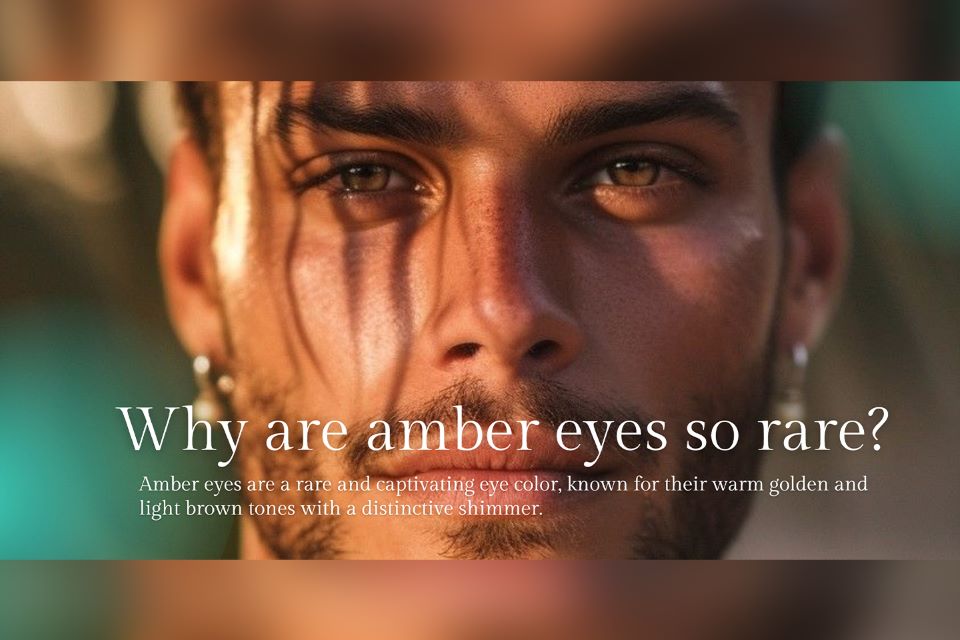Amber eyes are a rare and captivating eye color, known for their warm golden and light brown tones with a distinctive shimmer. Globally, fewer than 5% of people have amber eyes, making this eye color stand out in any crowd. These eyes don’t just glow uniquely in sunlight; they shift subtly in color with different lighting, leaving many enchanted. What exactly makes amber eyes so special? The science behind their formation, genetic background, and distribution across different ethnicities holds fascinating mysteries. Culturally, amber eyes often symbolize mystery, wisdom, and a unique personality. In this article, we’ll dive into the secrets behind this rare and beautiful eye color.
Table of Contents:
What Are Amber Eyes?
Amber eyes are extremely rare, typically featuring a warm golden, light brown, and even a touch of copper shine. In sunlight, this color looks especially vibrant, almost like the eyes are reflecting a soft metallic glow. Unlike more common brown, blue, and green eyes, amber eyes have less melanin in the iris but more carotenoids, which give the eyes a natural warm tint. Carotenoids are natural yellow pigments that provide amber eyes with their unique luster, often reminding people of glimmering gemstones, full of mystery and allure.
Due to their rarity and warm tones, amber eyes are often seen as a symbol of charm and softness. Whether in sunlight or indoor lighting, amber eyes seem to have their own radiance. People with amber eyes often draw extra attention and admiration, making this color highly distinctive in any setting.
How Do Amber Eyes Form?
Amber eyes form through a complex biochemical process, primarily determined by the amount of melanin and carotenoids in the iris. Melanin plays the major role in controlling eye color depth, while carotenoids give amber eyes their warm golden or light brown tones. When the eye has lower levels of melanin and higher levels of carotenoids, the iris takes on the warm golden hues that characterize amber eyes. This unique pigment distribution allows amber eyes to reflect light in a way that produces a warm, almost metallic glow, creating an inviting, lively look.
The formation of amber eyes is also heavily tied to complex genetic interactions. Unlike the straightforward dominance of brown or recessiveness of blue, amber eyes result from the interaction of multiple genes, some influencing melanin production, while others affect carotenoid distribution. Even if neither parent has amber eyes, their child may still inherit the color due to genetic recombination or recessive gene inheritance. This unpredictability adds to the rarity and uniqueness of amber eyes in the population.
Besides genetics and pigment distribution, environmental factors and lifestyle may also cause subtle variations in amber eye color. Studies suggest that an individual’s health, nutrition, and hormone levels can affect pigment production, leading to slight shifts in eye color. For example, a diet rich in carotenoids could impact the distribution of these pigments, while hormonal changes might influence melanin levels. Though these changes are usually minor, they contribute to the diverse formation of amber eyes, adding a layer of natural beauty and unpredictability to this rare color.
How Common Are Amber Eyes?
Amber eyes are extremely rare worldwide, with fewer than 5% of people having this color. This rarity makes amber one of the most unique eye colors on the planet. By comparison, brown and blue eyes are far more common in many regions, especially with brown eyes dominating globally. The occurrence of amber eyes often depends on specific genetic combinations, which are unevenly distributed, making amber eyes more prevalent in certain areas. This scarcity makes amber eyes especially eye-catching and adds a layer of mystery and beauty to those who possess them.
Amber eyes vary in frequency by geography. For instance, amber eyes appear more frequently in some populations in Asia and South America, likely influenced by genetic diversity and historical intermingling in these areas. In contrast, amber eyes are extremely rare in Europe and Africa, where brown or blue eyes are more common. North America also has a limited distribution of amber eyes, though its genetic diversity occasionally brings this unique color to light.
Amber Eyes Across Different Ethnicities
The distribution of amber eyes varies significantly among ethnic groups, showcasing the rich genetic diversity worldwide. Certain populations in Asia and South America have a slightly higher rate of amber eyes, whereas it’s rare in places like Europe and Africa, where darker brown or blue eyes tend to be more common. This may be due to genetic makeup in these regions favoring darker colors, which reduces the likelihood of amber eyes.
Different cultures also interpret amber eyes in various ways. In Asian culture, amber eyes are considered a sign of warmth and harmony, symbolizing good fortune. In Western folklore, amber eyes are associated with mystery and spirituality, often linked to characters with insight or wisdom. Amber eyes aren’t just a visual trait but also carry rich cultural meanings.
How Amber Eyes Differ from Other Eye Colors
Amber eyes stand out visually and culturally compared to other eye colors. Darker eyes tend to convey depth, blue eyes a sense of clarity, while amber eyes offer a warm glow, creating a calm, approachable feel. Their light tone and metallic sheen make them both vivid and gentle, contrasting with the mysterious undertones of green eyes.
Amber eyes also have unique qualities under different lighting. In bright sunlight, they show more intense golden tones, while in indoor lighting, they may appear closer to brown. This subtle color change gives amber eyes a distinct visual experience, showcasing nature’s diverse beauty.

Myths and Beliefs Surrounding Amber Eyes
Amber eyes have long carried associations with mystery and power. In ancient myths, those with amber eyes were believed to have a deep connection with nature, representing luck and longevity. In some cultures, amber eyes are seen as a “gift from the gods,” symbolizing a rare intuition and insight, sparking images of unknown powers.
Although science has explained the genetic basis of amber eyes, their beauty and rarity still cast a mystical glow in people’s minds. In both real life and popular culture, amber eyes often symbolize wisdom, sharp perception, and a sense of mystery, giving those with this color an extraordinary allure.
Can You Change Your Eye Color to Amber?
With the beauty and rarity of amber eyes, many people wish they had this color. However, options to change eye color permanently are still limited. For now, colored contact lenses are the most popular way to temporarily get the look of amber eyes. Laser surgeries aim to reduce melanin in the iris for a color change, but these procedures are still under research and carry risks.
For most people, wearing colored contact lenses is still the easiest way to experience amber eyes. As technology advances, there may be safer ways to achieve permanent color changes, but for now, colored contacts remain the best option.
Health Tips for Amber Eyes
Amber eyes have less melanin, making them more sensitive to UV light, so protecting them is essential. UV-protective sunglasses are a must, especially in bright sunlight, as they help shield the retina from harmful rays. When spending time outdoors, those with amber eyes should consider wearing sunglasses, hats, or even using umbrellas to prevent sun-related eye strain.
Along with wearing sunglasses, avoiding peak UV hours like midday can reduce sun exposure and minimize eye fatigue. Indoors, lowering light intensity or using softer lighting can also help protect eyes and lessen strain.
Keeping amber eyes healthy also requires balanced nutrition and good habits. Foods rich in vitamins A and C, along with antioxidants like carrots, spinach, and blueberries, are particularly beneficial for eye health. These nutrients strengthen the retina and reduce free radical damage. Staying hydrated and keeping eyes moisturized are also important. Combined with regular outdoor activity and sufficient sleep, these habits support eye health, helping amber eyes maintain their beauty and clarity for the long term.
Conclusion
The formation of amber eyes is a complex and fascinating blend of genetics and biochemistry, a cultural symbol representing mystery and wisdom. The way these eyes shift subtly in sunlight and their rare occurrence makes them precious. Whether encountering amber eyes in real life or through fictional characters, they have a unique allure that stirs curiosity and admiration. We hope this article has helped you gain deeper insight into the wonders behind amber eyes, along with their special place in human culture. Amber eyes are a gift from nature—a timeless and rare beauty.



